
Alkmaar is a city and municipality in the Netherlands, located in the province of North Holland. Alkmaar is well known for its traditional cheese market. For tourists, it is a popular cultural destination. The municipality has a population of 111,766 as of 2023.
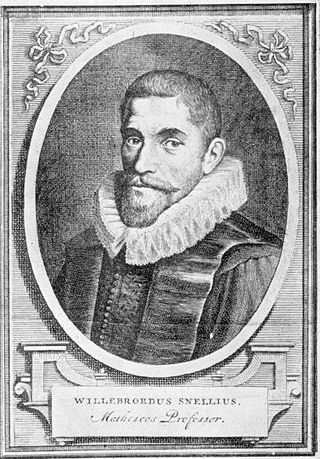
Willebrord Snellius was a Dutch astronomer and mathematician, AKASnell. His name is usually associated with the law of refraction of light known as Snell's law.
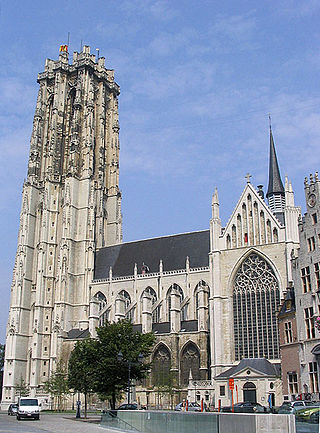
St. Rumbold's Cathedral is the Roman Catholic metropolitan archiepiscopal cathedral in Mechelen, Belgium, dedicated to Saint Rumbold, Christian missionary and martyr who founded an abbey nearby. His remains are rumoured to be buried inside the cathedral. State-of-the-art examination of the relics honoured as Saint Rumbold's and kept in a shrine in the retro-choir, showed a life span of about 40 years and a death date between 580 and 655, while tradition had claimed 775 AD.

The Grote Kerk or St.-Bavokerk is a Reformed Protestant church and former Catholic cathedral located on the central market square in the Dutch city of Haarlem. Another Haarlem church called the Cathedral of Saint Bavo now serves as the main cathedral for the Roman Catholic Diocese of Haarlem-Amsterdam.
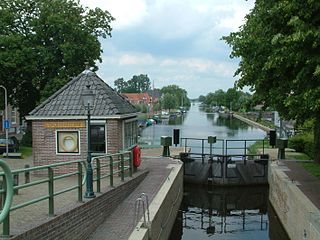
Zwartsluis is a small city in the Dutch province of Overijssel. It is located in the municipality of Zwartewaterland, at the mouth of the Zwarte Water river and the Meppelerdiep canal.

The Catholic Cathedral Church of St. John (Sint-Janskathedraal) of 's-Hertogenbosch, North Brabant, is the height of Gothic architecture in the Netherlands. It has an extensive and richly decorated interior, and serves as the cathedral for the bishopric of 's-Hertogenbosch.

De Rijp is a village and former island in the Dutch province of North Holland. It is a part of the municipality of Alkmaar, and lies about 10 km northwest of Purmerend, between the Schermer and the Beemster polders. Before the poldering of the lakes surrounding it, De Rijp was famous for its herring industry. Today it is known for its characteristic rijksmonuments, which include some of the oldest wooden houses of North Holland.
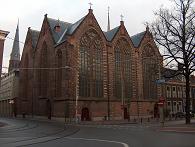
The Kloosterkerk is a church on the Lange Voorhout in The Hague, Netherlands. The church and its accompanying monastery were first built in 1397. The church is known today as the church where Beatrix of the Netherlands occasionally attended services.

The Sint Janskerk in Gouda, the Netherlands, is a large Gothic church, known especially for its stained glass windows, for which it has been placed on the list of the top 100 Dutch monuments.

The Protestant church of Jistrum or Saint Peter's church is a medieval religious building in Jistrum, Friesland, Netherlands. It is a well preserved and complete 13th century Romanesque church built of red brick, located in the center of the village on Schoolstraat 2. The church is listed as a Rijksmonument, number 35645.

St. Martin's Church is a Protestant church in Bolsward, Netherlands, and one of the medieval churches in Friesland. The current church was built between 1446 and 1461, the small medieval church which stood at that location previously was demolished to build the new one. The tower of the church was built in the 15th century and the gabled roof was added in the 17th century. It became a Protestant church during the Reformation. There was a major renovation which, apart from work on the tower, ended in 1955.

Brabantine Gothic, occasionally called Brabantian Gothic, is a significant variant of Gothic architecture that is typical for the Low Countries. It surfaced in the first half of the 14th century at St. Rumbold's Cathedral in the city of Mechelen.
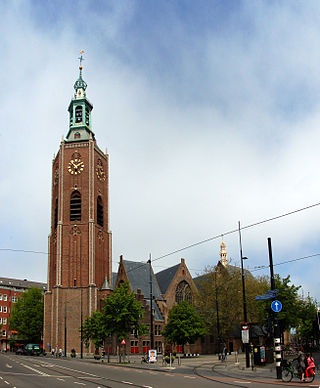
The Great Church or St. James' Church is a landmark Protestant church in The Hague, Netherlands. The building is located on the Torenstraat, named for its high tower. Together with the Binnenhof, it is one of the oldest buildings in The Hague. Members of the House of Orange-Nassau have been baptised and married there. The latest are King Willem-Alexander of the Netherlands and his daughter and heir apparent Catharina-Amalia, Princess of Orange.

Grote of Sint-Laurenskerk is a Protestant church in Rotterdam. It is the only remnant of the medieval city of Rotterdam.

Johannes Gijsbertus Bastiaans was a Dutch organist, composer and music theorist. Bastiaans was educated in organ playing from the age of ten in Deventer. He studied to become a watchmaker and settled in Rotterdam. There he meet C.F. Hommert, who introduced him to the works of Johann Sebastian Bach.

The Waag building is a National monument (Rijksmonument) listed building on the Waagplein in Alkmaar in the Netherlands. On this square Waagplein every Friday from April till the second week of September, the famous cheese market is held. The Dutch Cheese Museum and the tourist information Office (VVV) are also in the building. In the tower is a famous carillon weekly played by a carillonneur and also automatically by a drum chiming the quarters of the hour. There is also the famous automatic horse with knights play in the tower with an automatic trumpetplayer.

The Heuvelse kerk is a neo-Gothic Catholic church in the center of the Dutch city Tilburg. Dedicated to Saint Joseph, it is one of two major Catholic churches in the city center together with the Heikese kerk. It is located along the square Heuvel, after which it is named. A 1921 statue of the Sacred Heart is located in front of the building.

The Dutch Reformed Church of Zwartsluis is a historic Dutch Reformed church building located on the Kerkstraat in Zwartsluis, Netherlands.
Franz Caspar Schnitger was a German organ-builder active in the Netherlands.






















